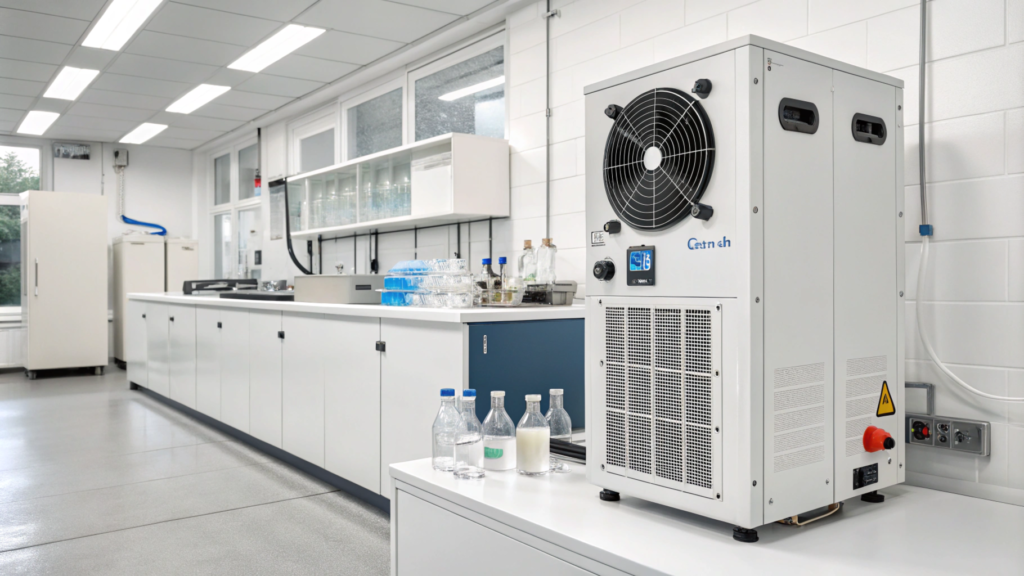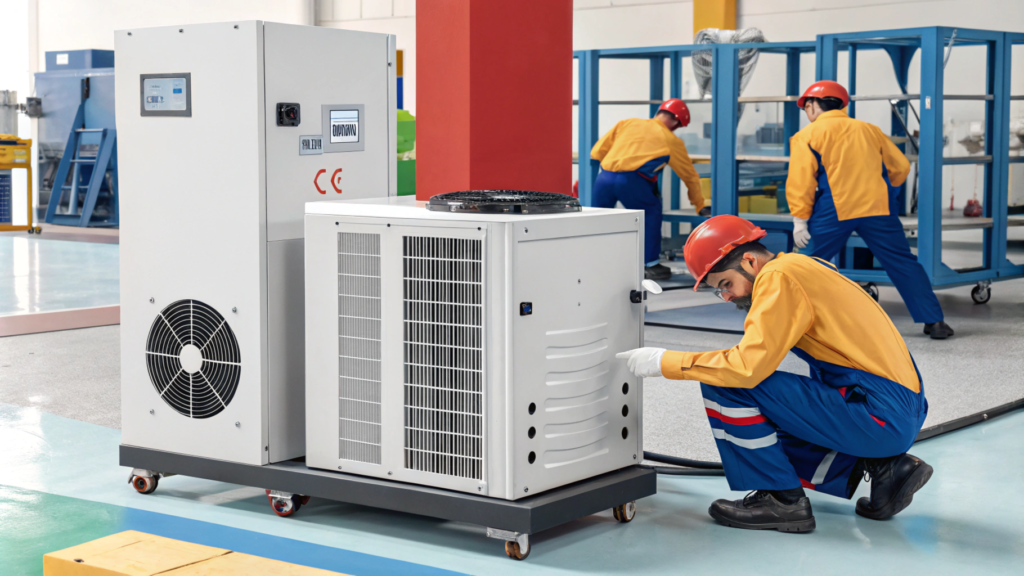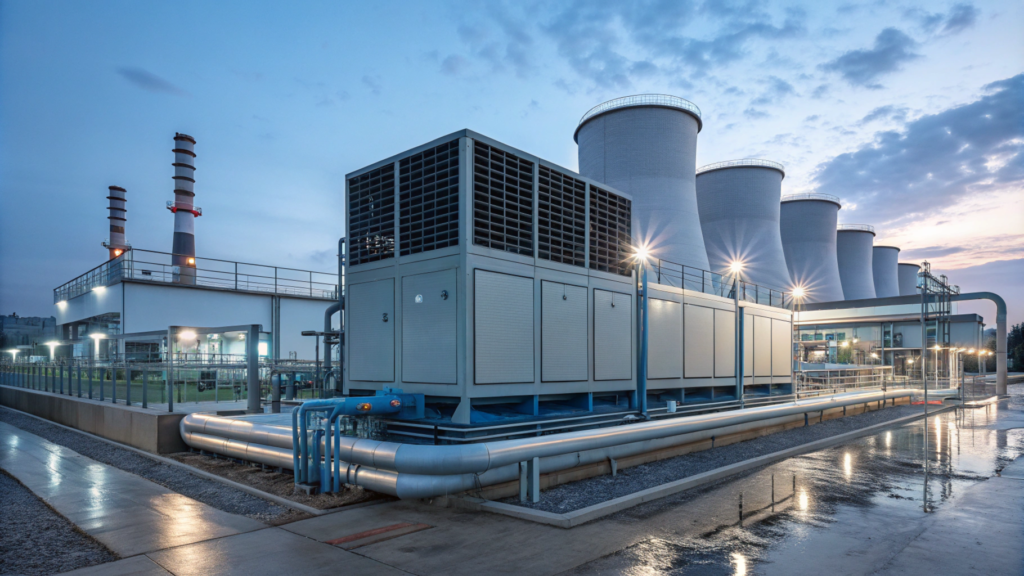
Choosing the right water chiller for your needs can be overwhelming with so many options available. Each type serves specific purposes and industries, so understanding them is crucial.
Water chillers come in various types like air-cooled, water-cooled, and specialized chillers designed for distinct applications. Each has unique features, pros, and cons.
Let's dive deeper into the world of water chillers and explore each type to uncover its benefits and applications.
[Table of Contents]
What are air-cooled chillers, and when should you use them?
Air-cooled chillers use air to remove heat from the cooling system, making them ideal for areas with limited water access.
They are portable, easy to install, and cost-effective in regions where water resources are scarce or expensive. Learn more1.

Dive Deeper: Benefits and Limitations
-
Benefits:
- Lower maintenance than water-cooled systems.
- No need for a separate cooling tower.
- Quick and simple installation.
-
Limitations:
- Higher power consumption compared to water-cooled chillers.
- Performance decreases in high-temperature environments.
How do water-cooled chillers compare to air-cooled ones?
Water-cooled chillers use water for heat exchange, making them more efficient in environments with consistent water supplies.
These chillers are known for their superior cooling capacity and energy efficiency in controlled conditions. Learn more2.

Dive Deeper: Key Features and Applications
- Key Features:
- Requires a cooling tower, increasing initial setup costs.
- Quiet operation due to efficient heat dissipation.
- Longer lifespan when properly maintained.
What are laser chillers, and why are they essential?
Laser chillers are specialized for cooling laser systems used in manufacturing, medical, and research industries.
They ensure stable temperatures, preventing overheating and improving laser performance and longevity. Learn more3.
Why are UV water chillers indispensable for UV systems?
UV water chillers control the temperature of UV lamps and systems, essential in industries like printing and disinfection.
They ensure consistent UV output and protect systems from heat-related damage. Learn more4.
What are ice bath chillers, and how do they support recovery?
Ice bath chillers rapidly cool water for therapeutic recovery in sports and rehabilitation settings.
They are essential for reducing inflammation, improving circulation, and aiding muscle recovery. Learn more5.
How do glycol chillers protect your systems?
Glycol chillers use a glycol-water mixture for cooling, providing freeze protection in extreme temperatures.
They are ideal for applications requiring consistent cooling in sub-zero conditions. Learn more6.
What makes portable chillers convenient for diverse applications?
Portable chillers are compact and mobile, designed for small-scale or temporary cooling needs.
They offer flexibility and ease of use for various industries and processes. Learn more7.
What sets open-loop chillers apart from closed-loop ones?
Open-loop chillers circulate cooling water through external systems, ideal for specific industrial processes.
They are simpler and cost-efficient but require consistent water quality monitoring. Learn more8.
Why are closed-loop chillers better for contamination-sensitive processes?
Closed-loop chillers recirculate a coolant within a sealed system, preventing contamination.
They are ideal for applications requiring clean, reliable, and low-maintenance cooling. Learn more9.
How do scroll chillers achieve efficiency in compact systems?
Scroll chillers use scroll compressors, offering energy efficiency and quiet operation in smaller systems.
They are favored for light industrial and commercial applications. Learn more10.
Why are screw chillers known for high-capacity cooling?
Screw chillers use rotary screw compressors for high-capacity cooling, suitable for demanding industries.
They offer consistent performance and efficiency in large-scale operations. Learn more11.
What makes centrifugal chillers a powerhouse in the cooling industry?
Centrifugal chillers use centrifugal force to compress refrigerants, delivering unmatched efficiency in large systems.
They are the go-to solution for massive cooling projects. Learn more12.
Footnotes
-
Helps readers learn more about air-cooled chillers’ features and practical use cases. ↩
-
Aids in comparing the benefits and limitations of water-cooled systems against air-cooled ones. ↩
-
Explains why laser chillers are critical for industrial and medical applications. ↩
-
Provides insight into how UV water chillers improve UV system performance and longevity. ↩
-
Highlights the advantages of using ice bath chillers in sports therapy and rehabilitation. ↩
-
Offers readers information on industries benefiting from glycol chillers. ↩
-
Explains the practicality and benefits of portable chillers for diverse use cases. ↩
-
Helps readers understand the pros and cons of open-loop systems compared to closed-loop ones. ↩
-
Explains why closed-loop systems are reliable for contamination-sensitive environments. ↩
-
Provides additional resources on scroll chillers’ efficiency and use cases. ↩
-
Guides readers to learn about screw chillers’ role in large-scale cooling operations. ↩
-
Explains why centrifugal chillers are preferred for large-scale projects. ↩
